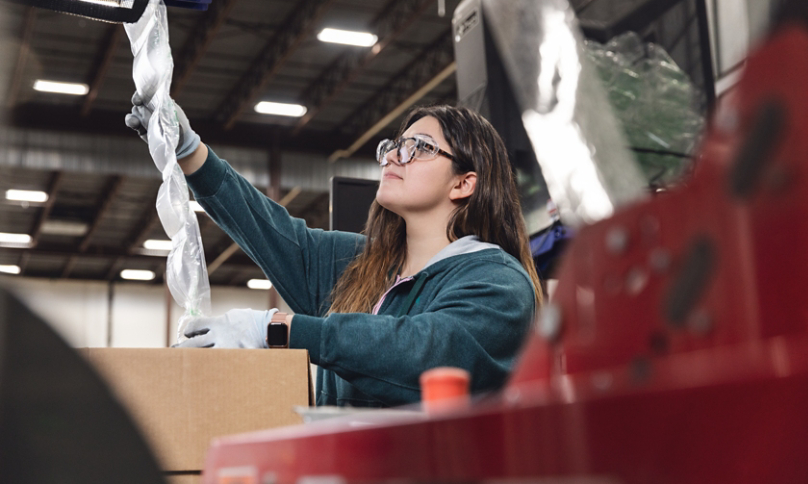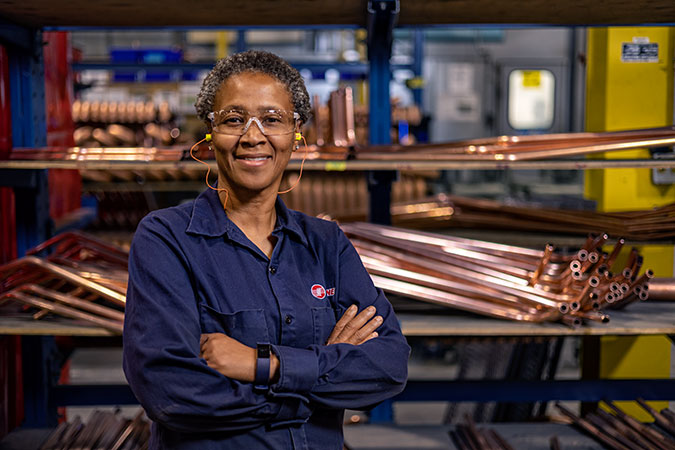
Our PeopleArticle
Welcome women into HVAC and the skilled trades
February 27, 2023
The HVAC industry can fill the growing need for skilled employees in HVAC and other trades by recruiting, hiring, training, and retaining women workers.

Our PeopleArticle
February 27, 2023
The HVAC industry can fill the growing need for skilled employees in HVAC and other trades by recruiting, hiring, training, and retaining women workers.
From contractors to engineers to welders to maintenance and service technicians, skilled employees are the No. 1 resource the HVAC industry depends upon most to meet the growing demand for comfortable indoor climates. The American Welding Society projects that by 2026 the U.S. will need 336,000 more welders. That need is driven by the number of currently unfilled positions, attrition, and new job positions generated by industry growth.
How is the HVAC industry going to meet the massive labor needs? We’ll only build the teams we need by recruiting, hiring, training, and retaining women for careers in essential HVAC professions. Inviting more women into the HVAC ecosystem will help close the labor gap it’s experiencing and create a more diverse and approachable culture.
The good news is that in some areas of the HVAC workforce, women’s representation is growing. As of 2019, 15% of engineering professionals are women. We’re seeing women engineers working in mechanical and system design, consulting and specifying, and with contractors. But the inclusion of women in the trades like welding, pipefitting, and ironwork is lackluster. Women fill only 4% of all construction and trade jobs.
First, we need to be vocal that we want women workers on our team and make them feel welcome! We must actively recruit, hire, train, and retain women in HVAC and the trades. Low female representation is not due to a lack of interest from women.
A comprehensive survey conducted by the Institute for Women’s Policy Research (IWPR) found that tradeswomen are attracted to trade jobs for high earnings, good benefits, the opportunity to do physical work, and to contribute and find community. The No. 1 barrier to more women entering the trades is that women aren’t aware of the opportunities, much less the training requirements or what it takes to succeed.
“The No. 1 barrier to more women entering the trades is that women aren’t aware of the opportunities, much less the training requirements or what it takes to succeed.”
Michelle Murphy
Vice President of Human Resources
Second, we must debunk the myth that women can’t work in trades. To do so, Trane Technologies interviewed three women professionals in different HVAC careers to get their take on how women can succeed in HVAC and the trades. They also debunked a few time myths in the process:
Most women can do all the physical work required for a trade job. Hayley Whiting, an apprentice pipefitter in Chicago Union Local 597, participated in an apprenticeship and training program hosted by Chicago Women in the Trades (CWIT) and a Technical Opportunities Program (TOP)—where she learned what would be required of her physically to succeed as a certified welder.
“Day one, you have to pick up the things that are heavy. If you think you’re capable of picking it up, pick it up. If you’re capable of doing the work, do the work because it’s worth it,” shared Whiting.
Some skilled jobs in HVAC cost only thousands of dollars for training and women can earn money while learning a trade and earning certifications. Trade professions use a tiered system of skill-building that starts with apprenticeships.
According to the U.S. Department of Labor, 92% of apprentices who complete an apprenticeship retain employment, with an average annual salary of $72,000.
“Three of my third-year apprentices have all purchased homes,” said Beth Rovazzini, president of B&W Plumbing and Heating in Indianapolis, Indiana.
Most women apprentices are 25 years old or older, and 43% are 35 years or older. Many women have entered the trades as a career change.

Thousands of women working in the trades balance family life and trade work. In the IWPR survey, 50% of the tradeswomen, apprentices, and journey workers have children younger than 18 years old, and 21.9% have children younger than six. Rovazzini notes that a much better work-life balance has evolved in the HVAC industry.
Professional Engineer (P.E.) Jessica Ely shared that a network of mentors, coaches, and sponsors helped her advance upward through her multi-staged career in HVAC engineering and contracting.
“I had a mentor that turned sponsor,” Ely said. “That was a pivotal moment for me--he advocated for me when he was at the table, but I wasn’t. He encouraged me to be bold and push way beyond my capabilities.”
Women and tradeswomen organizations also effectively promote trade jobs to women and provide training, support, and education for women entering the trades. And many unions have women’s committees or sponsor programs to encourage participation in the trades and help women find financial support for training costs.
As promising as trade careers are for women, ominous barriers can still exist, including sexual harassment, discrimination, and lack of promotion, advancement, and equal pay. The only way to rapidly change those conditions is to increase female representation in HVAC and trade professions.
Trane Technologies is working to remove systemic barriers to diversity and inclusion by creating an inclusive culture, holding leaders accountable, and changing our policies and procedures to create a diverse workforce. We invite our industry peers, vendors, supplies, distributors, and competitors to join us. Now is the time for HVAC to welcome women of all ages, races, and backgrounds to consider the benefits and possibilities of careers in HVAC.

Recommended for you
Our People Video
How Alessandra Hammond Makes Our Supply Chain More SustainableNovember 18, 2024
We believe every job at Trane Technologies can be a sustainability job. Learn how Alessandra Hammond builds systems and processes to advance sustainability goals.
Our People Video
Organic Growth: The Carolina Farm Trust and Trane TechnologiesNovember 08, 2024
The Carolina Farm Trust increases access to locally grown produce and drives growth in the regional food economy.
Our People Article
Sustainability in Disaster ResponseOctober 17, 2024
Translating our desire to help into a sustainable response to natural disasters.
Our People Article
How Emma Van Fossen Helps Make Buildings GreenerOctober 09, 2024
We believe every job at Trane Technologies can be a sustainability job. Learn how Emma reduces the emissions of buildings through her work as an energy engineering team lead.